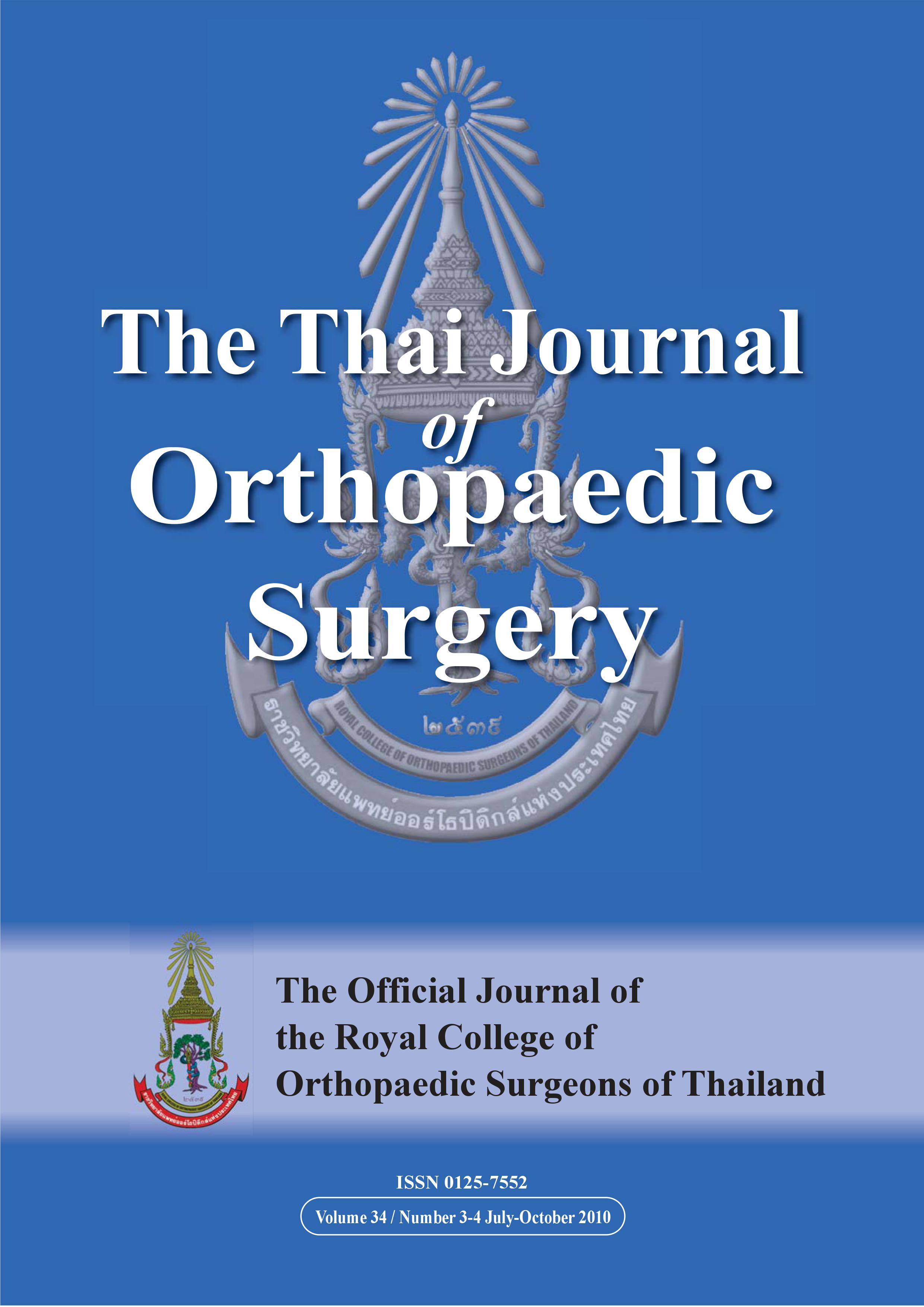The Effect of Total Lymphocyte Count on Postoperative Complications in Elderly Patients with Hip Fractures
Main Article Content
Abstract
Objective: To evaluate the effect of total lymphocyte count on postoperative complications in elderly patients with hip fractures.
Methods: In-patient medical records of elderly patients with hip fracture surgery including patient demographic, site of fracture, comorbidities, postoperative complications, operative technique, length of stay, hematocrit, total lymphocyte count and albumin were reviewed then evaluated the effect of total lymphocyte count on postoperative complications
Results: 16 males and 52 females with mean age 73.81±8.17 years were included in this study. 37 patients had postoperative complications. There were 4 postoperative deaths. Patients with low total lymphocyte count had a higher prevalence of postoperative complications as compared with patients with normal total lymphocyte count but the difference was not statistically significant.
Conclusions: From this study, total lymphocyte count had no statistically significant affect on postoperative complications in elderly patients with hip fractures. However, patients with low total lymphocyte count had a higher prevalence of postoperative complications than patients with normal total lymphocyte count.
Article Details
References
2. Zuckerman JD, Skovron ML, Koval KJ, Aharonoff GB, Frankel VH. Postoperative complications and mortality associated with operative delay in older patients who have a fracture of the hip. J Bone Joint Surg Am. 1995; 77(10): 1551-6.
3. Chandra RK. The relation between immunology, nutrition and disease in eldery people. Age Ageing. 1990; 19(4): S25-31.
4. Koval KJ, Maurer SG, Su ET, Aharonoff GB, Zuckerman JD. The effects of nutrition status on outcome after hip fracture. J Orthop Trauma. 1999; 13(3): 164-9.
5. Jensen JE, Jensen TG, Smith TK, Johnston DA, Dudrick SJ. Nutrition in orthopaedic surgery. J Bone Joint Surg Am. 1982; 64(9): 1263-72.
6. Fletcher JP, Little JM, Guest PK. A comparison of serum transferrin and serum prealbumin as nutrition parameters. JPEN J Parenter Enteral Nutr. 1987; 11(2): 144-7.
7. Patterson BM, Cornell CN, Carbone B, Levine B, Chapman D. Protein depletion and metabolic stress in eldert patients who have a fracture of the hip. J Bone Joint Surg Am. 1992; 74(2): 251-60.
8. Foster MR, Heppenstall RB, Friedenberg ZB, Hozack WJ. A prospective assessment of nutrition status and complications in patients with fracture of the hip. J Orthop Trauma. 1990; 4(1): 49-57.
9. Grossbard LJ, Desai MH, Lemeshow S, Teres D. Lymphocytopenia in the surgical intensive care unit patient. Am Surg. 1984; 50(4): 209-12.
10. Zuckerman JD, Koval KJ, Aharonoff GB, Hiebert R, Skovron ML. A functional recovery score for elderly hip fracture patients: I. Development. J Orthop Trauma. 2000; 14(1): 20-5.
11. Tartter PI. Preoperative lymphocyte subsets and infectious complications after colorectal cancer surgery. Surgery. 1988; 103(2): 226-30.
12. Oztürk A, Ozkan Y, Akgöz S, Yalçýn N, Ozdemir RM, Aykut S. The risk factors for mortality in elderly patients with hip fractures: postoperative one-year results. Singapore Med J. 2010; 51(2): 137-43.
13. Symeonidis PD, Clark D. Assessment of malnutrition in hip fracture patients: effects on surgical delay, hospital stay and mortality. Acta Orthop Belg. 2006; 72(4): 420-7.
14. Bistrian BR, Blackburn GL, Hallowell E, Heddle R. Protein status of general surgical patients. JAMA. 1974; 11: 144-7.
15. Mizrahi EH, Fleissig Y, Arad M, Blumstein T, Adunsky A. Admission Albumin levels and function outcome of eldery hip fracture patient: is it that important?. Aging Clin Exp Res. 2007; 19(4): 284-9.
16. Derek JD, Nicolas AG, Keith B, Edwin EM, John LE, Samir M. Use of Medical Comorbidities to Predict Complications After Hip Fracture Surgery in the Elderly. J Bone Joint Surg Am. 2010; 92(4): 807-13.


